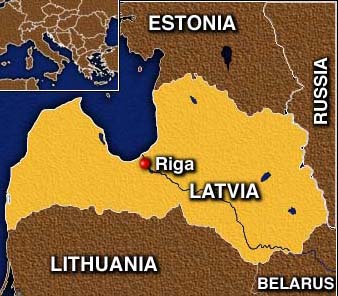Blame game starts after night of rioting in Latvia
 Riga- Workers were busy replacing paving stones into the cobbled streets of Riga's Old Town Wednesday morning hours after they were used to smash the windows of the Latvian parliament building.
Riga- Workers were busy replacing paving stones into the cobbled streets of Riga's Old Town Wednesday morning hours after they were used to smash the windows of the Latvian parliament building.
A political demonstration Tuesday night degenerated into the worst civil unrest the Baltic state has seen for years.
Speaking on Latvian television Wednesday morning, Prime Minister Ivars Godmanis warned that the 106 people arrested "will not go unpunished," and defended police tactics in bringing the riot under control.
Next time, Godmanis warned, the police response would be even tougher.
He also said political protests might be banned from the Old Town in future.
At a press conference on Wednesday afternoon, an emotional President Valdis Zatlers was careful to spread the blame.
After denouncing the "hooliganism" of the rioters he also warned the government it must listen to the people and pass constitutional amendments that would make it easier for voters to hold politicians accountable.
Unless the necessary changes are made by March 31, he would initiate a referendum on the dissolution of parliament, Zatlers warned.
"The prime minister must urgently, within a week or two, propose a clear model for reorganization of the government.
"He should propose not options, but a clear model about which institutions will be reformed so that not only the civil servants but also the public would know it," Zatlers said.
Regular police and special riot units fought running battles with rioters, who were mainly young people, for nearly three hours.
Witnesses told Deutsche Presse-Agentur dpa tear gas was used, though police refused to confirm it was they who had used it.
Baton charges were used to restore order after a crowd several hundred strong attacked the Latvian parliament building with paving stones, smashing windows and doors.
At one point heavily armed elite paramilitary units took up positions inside the building, apparently preparing to defend it if the crowd tried to force its way inside.
An off-licence was looted, 14 police cars were damaged and 10 policemen received medical treatment.
Police eventually managed to contain rioters in narrow streets directly opposite the parliament building.
The violence was in stark contrast to the peaceful political rally that preceded it.
Around 10,000 Latvians gathered in the central Dome Square to protest against a range of government policies by singing songs and waving banners calling on Latvian president to dissolve the parliament.
Before the rally, fears had been expressed that the night could end in violence after rumours spread on the internet that some groups were seeking a confrontation, and though most attendees at the rally appeared to be normal students, pensioners and workers, dpa also noted the marginal presence of some strange bedfellows: neo-Nazi Latvian groups, extreme Russian nationalists and anti-gay protestors.
Aigars Stokenbergs and Artis Pabriks, two former government ministers who addressed the rally, made a point of calling for peaceful protest, but their pleas went unheeded by some sections of the crowd.
On Wednesday, Pabriks told dpa he suspected the event had been highjacked and hinted that the only winners from the situation were likely to be the People's Party, the largest party in the ruling coalition.
Interior Minister Mareks Seglins was scathing about Pabriks and Stokenbergs and reserved particular venom for Agris Suna, head of the police officers' trade union, which supported the demonstration.
"He should reconsider his staying on the Latvian police force," Seglins said, despite the fact that many off-duty police officers taking part in the rally rushed to help their colleagues when violence flared.
Andris Dzenis, head of Riga central police department, said on public radio Wednesday that the early stages of the violence appeared to have been planned in advance but that the riot had then developed its own momentum.
Whatever the reasons for the violence, there is little similarity with the last episode of civil disorder to rock the Baltic states.
In Estonia in April 2007, thousands of mainly Russian-speaking youths ran riot in the capital, Tallinn, after the government announced plans to relocate a Soviet war memorial.
In contrast, the Latvian rioters included both Latvian and Russian speakers, a fact confirmed by all eyewitnesses dpa spoke to on the scene. (dpa)